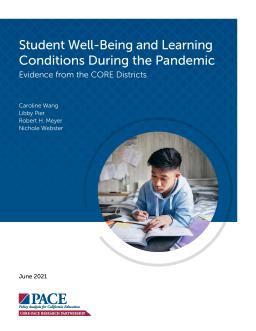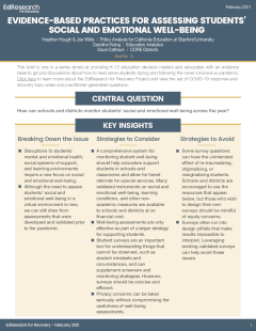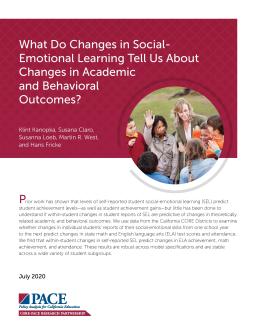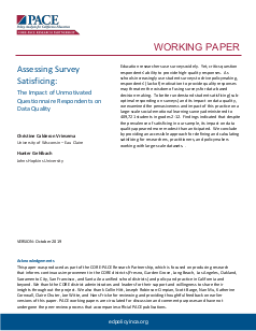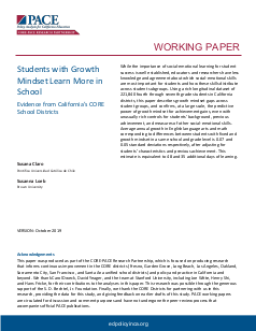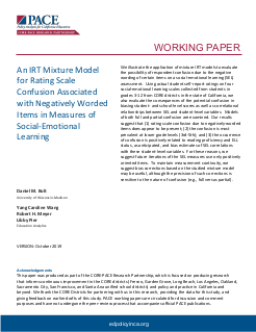Published
Summary
This report finds that improving school attendance is crucial, especially with the increase in chronic absence. Data on unexcused absences should be used to create a more preventive, problem-solving, and equitable response to poor attendance. Labeling absences as unexcused affects how students and families are treated and can lead to punitive measures that may not improve attendance. Overuse of the unexcused-absence label could undermine efforts to partner with students and families to improve attendance.
Published
Summary
This study explores the impact of reclassification on social-emotional learning skills (SEL) of English learners (ELs) in grades 4 to 8. Using a regression discontinuity design, the study found that reclassification improved academic self-efficacy by 0.2 standard deviations for students near the cutoff threshold. The results suggest that reclassification can positively influence the academic beliefs of ELs and the authors provide recommendations for districts to create practices that foster such positive beliefs.
Published
Summary
This study explores the impact of county-level immigration arrests on the academic achievement, attendance, and perceptions of school climate and safety for Latinx and Latinx English learner students in California's CORE districts. The research found that there is a negative relationship between immigration arrests and these students' academic performance and school experiences. The study recommends policies and practices that can help schools and districts create safer, more welcoming environments for immigrant-origin students and families in the face of anti-immigrant actions.
The Impact of Unmotivated Questionnaire Responding on Data Quality
Published
Summary
This article explores the issue of satisficing, which is suboptimal responding on surveys, in the context of a large-scale social-emotional learning survey administered to over 400,000 elementary and secondary students. Despite concerns about its impact on data quality, the study found that satisficing had a more modest effect than expected. The article offers an approach for defining and calculating satisficing for researchers, practitioners, and policymakers to improve the quality of survey data.
Evidence from the CORE Districts
Published
Summary
The CORE Districts in California conducted a survey to measure K-12 students’ social-emotional well-being during the pandemic. Results indicate that students’ personal and interpersonal well-being rated lower than their learning environments. Interpersonal well-being was most correlated with academic achievement. Home/online learning environment improved, but Grades 5-12 students reported not liking school as much in winter 2020-21. Stakeholders should focus on meeting the pressing needs of each group of students.
Published
Summary
This brief is one in a series aimed at providing K-12 education decision makers and advocates with an evidence base to ground discussions about how to best serve students during and following the novel coronavirus pandemic. Learn more about the EdResearch for Recovery Project and view the set of COVID-19 response-and-recovery topic areas and practitioner-generated questions here. The central question of this brief is: How can schools and districts monitor students’ social and emotional well-being across the year?
Published
Summary
This article assesses confusion due to negative wording on social-emotional learning (SEL) assessments using mixture IRT models. Results based on student self-reports show confusion biasing scores, especially in Grades 3-5, and correlational relationships between SEL constructs and reading proficiency and ELL status. Using positively oriented items in future SEL measures is recommended to address these issues.
Published
Summary
This study used data from California CORE Districts to explore whether changes in students' self-reported social-emotional learning (SEL) predicted changes in academic outcomes and attendance. The findings revealed that within-student changes in SEL were positively associated with improvements in English language arts (ELA) and math achievement, as well as attendance, and were consistent across various student subgroups.
Evidence From the First Large-Scale Panel Student Survey
Published
Summary
Self-report surveys are used to track students’ social-emotional development. This large-scale panel survey reveals that self-efficacy, social awareness, and self-management decrease after Grade 6, except for growth mindset. Female students report higher self-management and social awareness but lower self-efficacy than males in middle and high school. Students of color and economically disadvantaged students report lower levels of each construct. Policymakers should consider these trends and use self-reports to target interventions and resources.
Published
Summary
California's CORE districts have been collecting data since 2014 on social and emotional learning (SEL) and school climate and culture to improve K-12 schools' holistic approach to student development. Advocates argue that a focus on SEL and school culture will lead to higher academic achievement and better well-being for students. The CORE districts developed survey instruments for SEL competencies and school climate perceptions involving students, staff, and parents. Many states and districts have adopted SEL-specific curricula and disciplinary reforms.
Characteristics, Outcomes, and Transitions
Published
Summary
The CORE districts studied characteristics, outcomes, and transitions of students with disabilities (SWDs). Specific learning disability was the most common type. Males, African Americans, English learners, and foster youth were overrepresented. Chronic absence was higher for SWDs with multiple disabilities. Most SWDs entered special education in K-4 and exited in grades 8-12. These results help identify who may need targeted support.
The Impact of Unmotivated Questionnaire Respondents on Data Quality
Published
Summary
This paper investigates the effect of student satisficing, the act of providing suboptimal survey responses, on data quality in a large-scale social-emotional learning survey. The study examines the prevalence and impact of satisficing among 409,721 students and finds that its effect on data quality is less significant than expected. The paper offers a practical approach to defining and calculating satisficing, useful for researchers, policymakers, and practitioners working with large-scale datasets.
Evidence from California’s CORE School Districts
Published
Summary
This paper examines which social-emotional skills are most important for student success and how they vary among student subgroups. It uses longitudinal data from over 200,000 fourth through seventh grade students in California to explore growth mindset gaps across student groups and shows the significant predictive power of growth mindset for academic achievement gains, even when controlling for other social-emotional skills and background characteristics.
Published
Summary
This paper uses mixture IRT models to evaluate whether students experience confusion due to negative wording of items on a social-emotional learning assessment. It examines the consequences of confusion on student- and school-level scores and correlations with student-level variables, finding that confusion is present and most prevalent in lower grades, and is related to reading proficiency and ELL status. The study recommends the use of positively oriented items in future SEL measures, and suggests bias corrections based on the studied mixture model to maintain measurement continuity.
Consistent Gender Differences in Students’ Self-Efficacy
Published
Summary
This brief examines the consistency of the drop in academic self-efficacy during middle school across various student groups, such as demographics, achievement level, and school of attendance. The study finds that the drop is essentially universal across all groups, despite some showing lower self-efficacy than others. Additionally, schools vary in their students' level of self-efficacy, but do not differ much in this trend. The drop in academic self-efficacy is steeper for female students, resulting in lower self-efficacy for girls than boys throughout middle and high school.
Published
Summary
This study uses value-added models to explore whether social-emotional learning (SEL) surveys can measure effective classroom-level supports for SEL. Results show that classrooms differ in their effect on students' growth in self-reported SEL, suggesting that classroom-level effects may be larger than school-level effects. However, the low explanatory power of the SEL models means it's unclear if these are causal effects. The SEL measures also capture growth not measured by academic test scores, indicating that classrooms within schools may impact measurable student growth in SEL.
Findings From the First Large-Scale Panel Survey of Students
Published
Summary
This article discusses the use of standardized tests as the primary tool for assessing school-level growth in student outcomes, despite the emerging importance of social-emotional learning (SEL). It presents results from large-scale surveys of students on SEL constructs, and finds significant differences across schools in SEL growth, with magnitudes of differences similar to those for academic achievement. However, caution is recommended in interpreting measures as causal impacts of schools on SEL, as the goodness of fit of the value-added model was considerably lower for SEL measures.
Evidence from California’s CORE Districts
Published
Summary
This paper uses a large dataset to confirm that self-management skills predict student success and are a better predictor of student learning than other socio-emotional skills. Students with higher levels of self-management experience almost 80 days of additional learning. The paper also describes self-management gaps across student groups.
Published
Summary
This study examines the impact of target setting for non-academic indicators on school quality ratings in CORE districts' elementary schools. The authors found that non-academic measures of school quality vary over time, are not consistently associated with demographics, and are sensitive to small changes in rating thresholds. The results suggest a need for more research on target setting for non-academic indicators in school quality systems.
Published
Summary
This report presents benchmarking data on self-report student surveys measuring social-emotional learning (SEL) from nearly half a million students in grades 4 through 12 across 8 CORE districts in California. The data provide means and standard deviations by construct, grade level, and subgroup, and can serve as a proxy for a nationally-normed sample for other schools across the country looking to administer the CORE survey.
Published
Summary
This report examines the stability of school effects on social-emotional learning (SEL) over two years in California's CORE districts. The correlations among school effects in the same grades across different years are positive but lower than those for math and ELA. While these effects measure real contributions to SEL, their low stability draws into question whether including them in school performance frameworks and systems would be beneficial.
A Pragmatic Approach to Validity and Reliability
Published
Summary
This report discusses the validity and reliability of CORE Districts’ social-emotional learning (SEL) student-report surveys. Through a pragmatic approach, the report answers four guiding questions that explain different facets of validity for school leaders. The aim is to provide guidance around the use of SEL surveys within and outside of the CORE districts to facilitate decision-making for educational leaders.
Evidence from the CORE Districts
Published
Summary
This study examines how social-emotional skills develop from Grade 4 to Grade 12 and vary by gender, socioeconomic status, and race/ethnicity. Based on self-report student surveys administered to around 400,000 students in California, the study finds that social-emotional skills do not increase uniformly and vary across subgroups. Females have higher social awareness but lower self-efficacy than males. Economically disadvantaged students show improvement in high school. White students report higher social-emotional skills than African American and Latinx students.
An IRT Modeling Approach
Published
Summary
This study examines the properties of California's CORE Districts' SEL survey, which measures social-emotional learning in students. The survey was given to over 400,000 students in grades 3-12. The study uses both classical test theory and item response theory frameworks to analyze the data and make recommendations for modeling and scaling SEL survey data. Policy implications are discussed for educators, administrators, policy makers, and other stakeholders.
Findings from the First Large-Scale Panel Survey of Students
Published
Summary
This paper examines the use of social-emotional learning (SEL) measures to evaluate school-level growth in student outcomes. The study finds substantial differences across schools in SEL growth, suggesting that schools may contribute to students' SEL. However, caution is recommended in interpreting measures as the causal impacts of schools on SEL due to potential measurement error and omitted variables bias.




